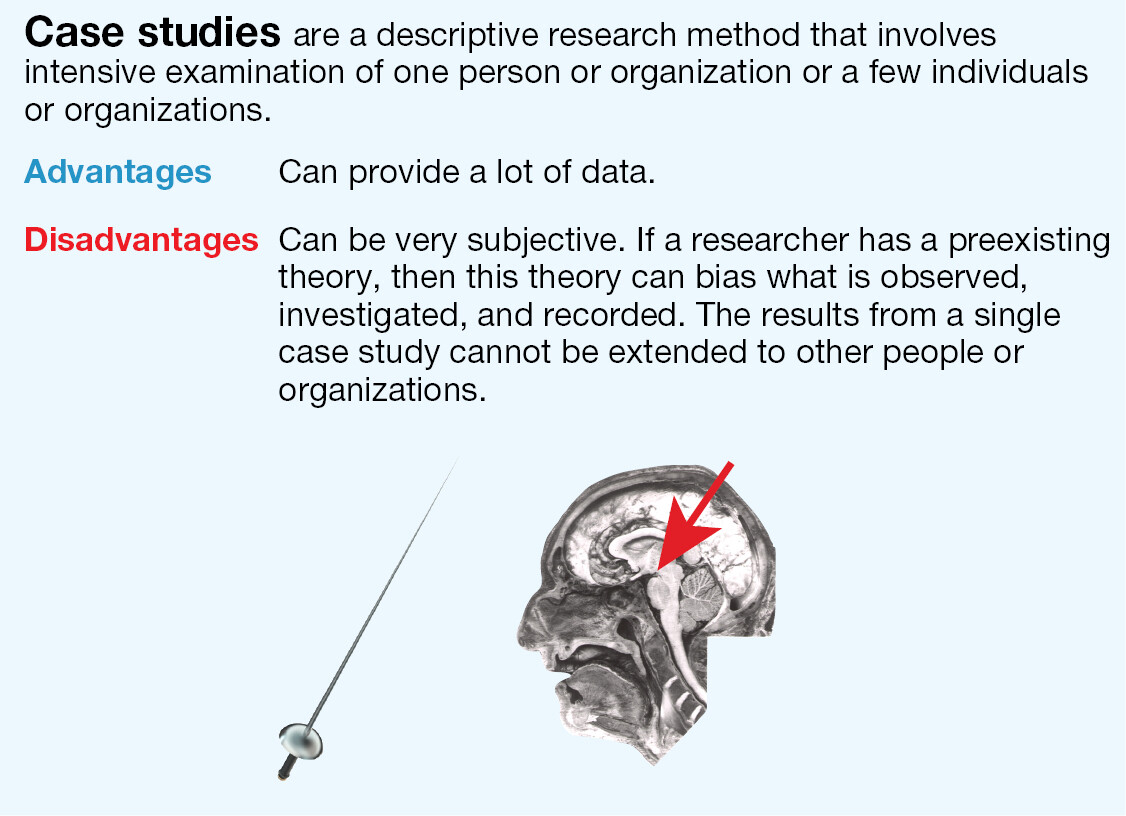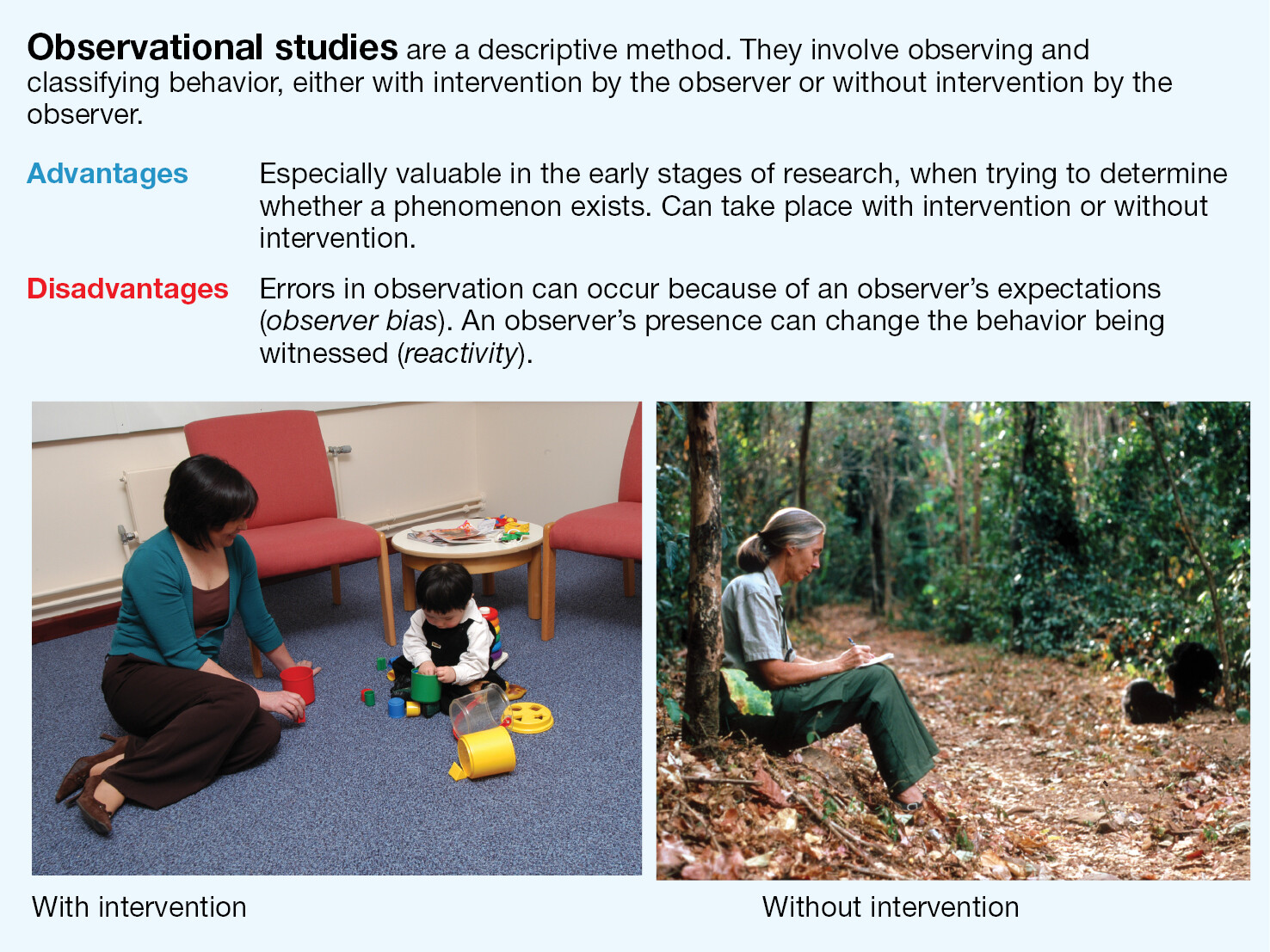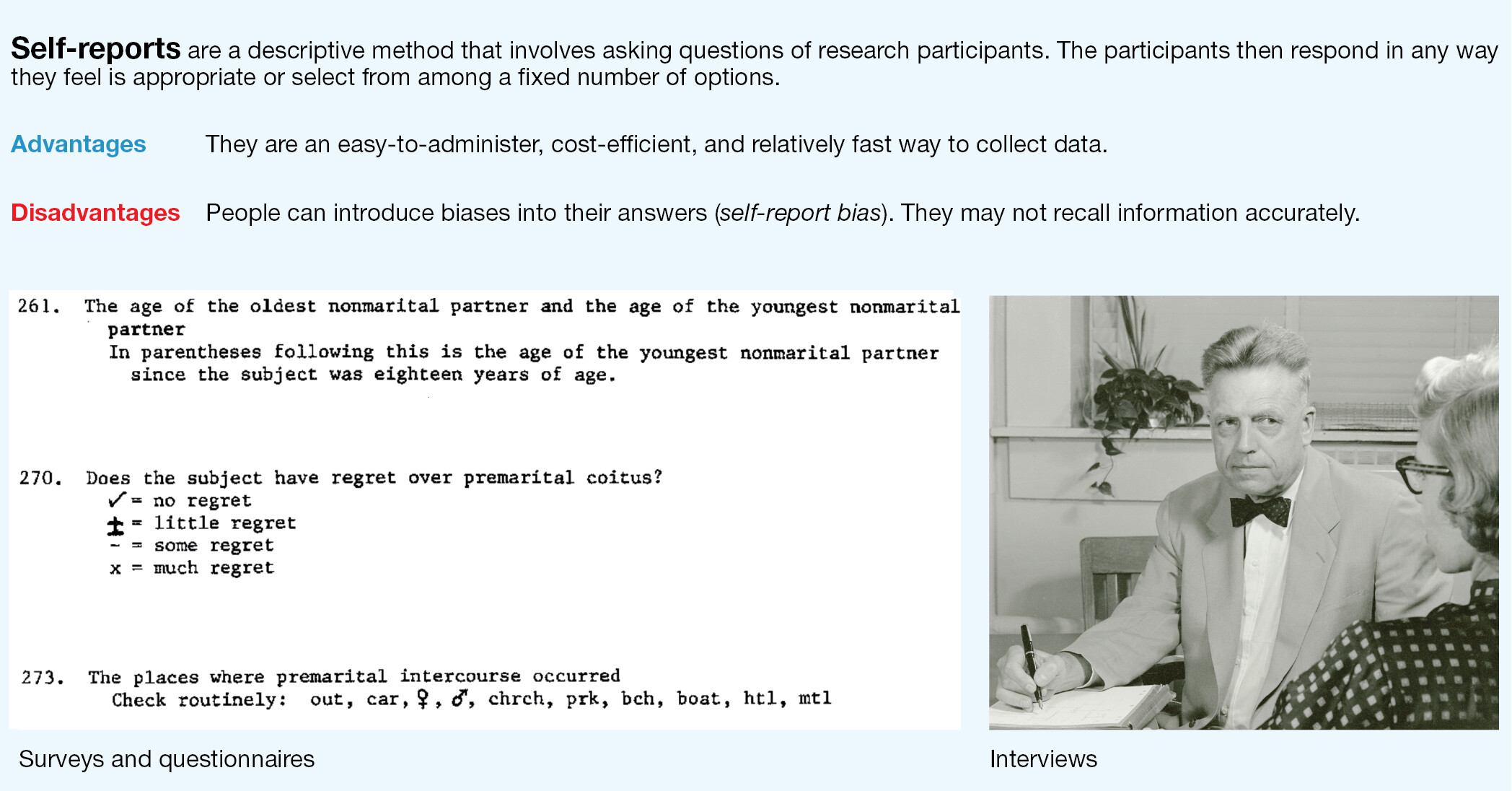Learning Goal
Explain the three types of descriptive methods used in research.
Learning Goal
Explain the three types of descriptive methods used in research.
Now that you have learned the five steps of the scientific method, you are ready to look at the process in more detail. This study unit focuses on the three main types of descriptive methods. You can also learn more about descriptive research, and the data obtained from this research method, in Appendix A.
Remember that after you have stated your testable research hypothesis in Step 2, in Step 3 you must decide which research method is best suited for your study (see Figure 1.18). Your choice of research method depends on the goal of your research and your hypothesis. If these pertain to describing behavior, then you will use one of the descriptive methods to collect data that test your hypothesis. Descriptive methods can provide a systematic and objective snapshot of what is occurring at a specific point in time. These methods are especially valuable in the early stages of research when researchers are trying to determine whether a particular phenomenon exists.
Recall that you might want to conduct a study on the question What study techniques do students believe are best? (See Figure 1.18, orange boxes.) Because this research has the goal of describing beliefs or behavior, you should use a descriptive method to investigate your research question. Let’s look at three descriptive methods you might use: case studies, observational studies, and self-reports. In the process, we will determine which of these three methods is most appropriate to use for this research study.
Case Studies Case studies involve intensive examination of just one person (or organization) or a few atypical people (or organizations). Because of this intense focus, case studies can yield a lot of data. For example, case studies of people with brain injuries have provided a wealth of evidence about which parts of the brain are involved in various psychological processes. In one case, a man referred to as N.A. suffered an injury when his roommate accidentally stabbed him through the nose and up into his brain with a fencing foil (Figure 1.20; Squire, 1987). Although N.A. seemed to recover, he unfortunately lost the ability to permanently store many types of new memories. Psychologists conducting research on N.A. were able to learn a lot about the regions of the brain that are involved in memory (Squire et al., 1989). In Chapter 7, you will learn more about how case studies reveal the brain regions involved in memory.

A text at the top reads: Case studies are a descriptive research method that involves intensive examination of one person or organization or a few individuals or organizations. Advantages - Can provide a lot of data. Disadvantages - Can be very subjective. If a researcher has a pre-existing theory, then this theory can bias what is observed, investigated, and recorded. The results from a single case study cannot be extended to other people or organizations. An illustration below shows a fencing foil and a schematic representation of a skull, with an arrow pointing to the hypothalamus of the brain.
FIGURE 1.20 Case Studies
N.A. provided an important case study that explored how an injury from a fencing foil (left) damaged a part of his brain (right) so that he was no longer able to form new permanent memories.
However, not everyone who suffers damage to this brain region experiences the same memory problems that N.A. had. This is a serious drawback of the case study method. Because one person or one organization is the focus of a case study, researchers cannot say if the same outcome will also occur with other people or other organizations.
Observational Studies Another type of descriptive method, observational studies involve systematically assessing and coding observable behavior across specific time intervals (Figure 1.21). Coding involves deciding which predefined category an observed behavior fits into. For example, researchers can use observational studies in a laboratory to categorize infants’ emotional responses to their caretakers after strangers came into the room for a few minutes (Ainsworth et al., 1978). When experimenters directly participate in an observed session, it is an observational study with intervention. That is, the researcher may interact with participants but does not control the situation to elicit certain responses. You will learn more about this type of observational research and what it reveals about how infants trust their caretakers in Chapter 4. As another example of observational research, the famous primatologist Jane Goodall conducted observational research with chimpanzees in natural settings in Tanzania across several generations of chimps. Because Goodall did not interact with the chimpanzees, she tried as much as possible to use observation without intervention.

A text at the top reads: Observational studies are a descriptive method. They involve observing and classifying behavior, either with intervention by the observer or without intervention by the observer. Advantages - Especially valuable in the early stages of research, when trying to determine whether a phenomenon exists. Can take place with intervention or without intervention. Disadvantages - Errors in observation can occur because of an observer’s expectations (observer bias). An observer’s presence can change the behavior being witnessed (reactivity). Two images below show observation with and without intervention. A woman sitting beside a child playing with toys depicts observation with intervention. An elderly woman sitting under a tree in a forest and writing depicts observation without intervention.
FIGURE 1.21 Observational Studies
(left) Psychologists can use observational studies to describe how infants react emotionally to their caretaker after the child has been with a stranger. (right) The primatologist Jane Goodall uses observational studies to describe the behavior of chimpanzees.
In this type of research using observation, researchers cannot control the behavior they are observing. Instead, they simply describe it. Observational research is critical in recording what is happening, so it is often a first step in new research where there is not a lot of existing data. The goal of the observational research is to learn what is happening. Then future research can attempt to predict, control, and explain the phenomenon.
You have most likely been a part of observational research in the past few months. Have you entered a store recently and noticed employees using a device to count customers? In parts of the country where mask-wearing was not mandated, observers may have been counting how many customers were wearing masks to protect against the spread of the novel coronavirus. Future research may then determine what factors make it more likely that people will wear masks when entering stores.
However, it is often difficult to observe a situation without seeing what you expect or want to see. In conducting observational studies, researchers must guard against observer bias in which errors in observation occur because of the observer’s expectations. Observer bias can be especially problematic if cultural norms favor behaving in certain ways. For instance, in many societies women are freer than men to express sadness. As a result, in coding men’s and women’s facial expressions, an observer may be more likely to code women’s expressions as indicating sadness. The same observer may tend to code men’s expressions of sadness as reflecting annoyance or some other emotion.
In addition, observational studies can produce artificial behavior that does not reflect how people or animals naturally behave. For example, the presence of an observer might alter the behavior being observed. Suppose the research participants want to make a positive impression on an observer. They may act differently when they believe they are being observed. A change in behavior as a result of being observed is called reactivity. A classic study on a form of reactivity, the Hawthorne effect, is described in the Methods of Psychology feature on page 32.
Self-reports For descriptive research in which the researcher wants to get information directly from many participants, neither case studies nor observational studies are appropriate. For such research, the researcher will often choose to get self-reports directly from the research participants.
Questionnaires and surveys are two common types of self-reports that researchers use to gather data from a large number of people in a short time. In these two types of self-reports, participants write answers to questions they are given. These research tools are easy to administer and cost-efficient. With people who cannot write answers on questionnaires or surveys (for example, young children), interviews can be used. Interviews, in which researchers directly ask questions, can yield valuable details about the respondents’ opinions, experiences, and attitudes. In addition, the answers to the interview questions may lead the researchers to ask questions they had not planned to ask. For instance, research in psychology has used questionnaires and interviews to learn more about the sexual behaviors of women and men in the United States (Figure 1.22; Kinsey et al., 1948; Kinsey et al., 1953). This self-report research has been critical in revealing that overall people are not solely attracted to people of the same sex or a different sex but rather that sexual attraction exists along a continuum.

A text at the top reads, Self-reports are a descriptive method that involves asking questions of research participants. The participants then respond in any way they feel is appropriate or select from among a fixed number of options. Advantages - They are an easy-to-administer, cost-efficient, and a relatively fast way to collect data. Disadvantages - People can introduce biases into their answers (self-report bias). They may not recall information accurately. An image, labeled Interviews, shows a man writing on a clipboard speaking to a woman at a table. An image, labeled Surveys and questionnaires, displays questions accompanied by options.
FIGURE 1.22 Self-Reports
(left) Psychologists may ask participants to complete surveys or questionnaires that reveal their mental activity or behavior (for example, about sex). (right) Alternatively, they can interview the participants, as Alfred Kinsey did in his research.
Hypothesis Being observed can lead participants to change their behavior.
Research The Hawthorne Effect
1 During studies of the effects of workplace conditions at the Hawthorne Works, a Western Electric manufacturing plant in Cicero, Illinois, between 1924 and 1933, the researchers changed the levels of lighting, pay incentives, and break schedules.

A text at the top reads, Hypothesis - Being observed can lead participants to change their behavior. Research Method, The Hawthorne Effect: 1, During studies of the effects of workplace conditions at the Hawthorne Works, a Western Electric manufacturing plant in Cicero, Illinois, between 1924 and 1933, the researchers changed the levels of lighting, pay incentives, and break schedules. An image below shows the front view of workers at a manufacturing plant. 2, The researchers then measured the speed at which workers did their jobs. An image below shows the back view of workers at a manufacturing plant. A text below reads, Results - The workers’ productivity increased when they were being observed, regardless of what was changed: light, pay incentives, or break schedule. Conclusion - Being observed can lead participants to change their behavior, perhaps because they want to make a good impression or be good participants for the study. Question - Which research method described in Figure 1.18 was used in this study? The answer to the question is inverted and reads: The research method used in this study is a descriptive method. Specifically, an observational study was used. The researchers changed various environmental factors at work, such as pay incentives. Then they watched workers to see the effects of these changes on the speed of their work.
2 The researchers then measured the speed at which workers did their jobs.

A text at the top reads, Hypothesis - Being observed can lead participants to change their behavior. Research Method, The Hawthorne Effect: 1, During studies of the effects of workplace conditions at the Hawthorne Works, a Western Electric manufacturing plant in Cicero, Illinois, between 1924 and 1933, the researchers changed the levels of lighting, pay incentives, and break schedules. An image below shows the front view of workers at a manufacturing plant. 2, The researchers then measured the speed at which workers did their jobs. An image below shows the back view of workers at a manufacturing plant. A text below reads, Results - The workers’ productivity increased when they were being observed, regardless of what was changed: light, pay incentives, or break schedule. Conclusion - Being observed can lead participants to change their behavior, perhaps because they want to make a good impression or be good participants for the study. Question - Which research method described in Figure 1.18 was used in this study? The answer to the question is inverted and reads: The research method used in this study is a descriptive method. Specifically, an observational study was used. The researchers changed various environmental factors at work, such as pay incentives. Then they watched workers to see the effects of these changes on the speed of their work.
Results The workers’ productivity increased when they were being observed, regardless of what was changed: light, pay incentives, or break schedule.
Conclusion Being observed can lead participants to change their behavior, perhaps because they want to make a good impression or be good participants for the study.
QuestionWhich research method described in Figure 1.18 was used in this study?
The research method used in this study is a descriptive method. Specifically, an observational study was used. The researchers changed various environmental factors at work, such as pay incentives. Then they watched workers to see the effects of these changes on the speed of their work.
Source: Roethlisberger, F. J., & Dickson, W. J. (1939). Management and the worker: An account of a research program conducted by the Western Electric Company, Hawthorne Works, Chicago. Harvard University Press.
A problem common with all self-report methods is that people’s answers can involve self-report bias. For example, people may not reveal personal information that casts them in a negative light. If you are in your twenties, imagine having an interviewer around your parents’ age ask you to describe intimate aspects of your sex life. If you are older, imagine a twentysomething interviewer asking the same question. How truthful would you be? Researchers have to consider whether their questions might lead a person to respond in a way that is most socially acceptable. Any distortion of the truth will affect the accuracy of the research results. Psychologists therefore design self-reports so that people feel comfortable providing information. For example, researchers are careful to apply the ethical standard of confidentiality and ensure participants that their responses will not be associated with their names or other aspects of their identity.
At the beginning of this study unit, we asked you to think about the best research method for the sample research question What study techniques do students believe are best? Which of the three descriptive methods will be helpful in answering this research question? The fact that you want to study many students rules out case studies. It might be tempting to think you can gather information about students’ preferred study methods by observing them studying, but suppose they are using a computer. How can you know whether they reading a textbook, answering questions on a homework assignment, or doing something else? Thus, an observational study likely will not give you the information you need. But if you created a questionnaire to ask students what study methods they use and think are best, or if you interviewed students directly, you could gather a lot of information about their instincts, beliefs, and opinions on the topic. In fact, psychologists have explored what study techniques students use the most, and they report that 78 percent of students say that rereading information in the textbook is one of their most popular methods of study (Miyatsu et al., 2018). However, we must be cautious because the study technique that students prefer may not actually be the technique that works the best. Let’s look now at another research technique that may be helpful.
LEARNING GOAL CHECK: REVIEW & APPLY